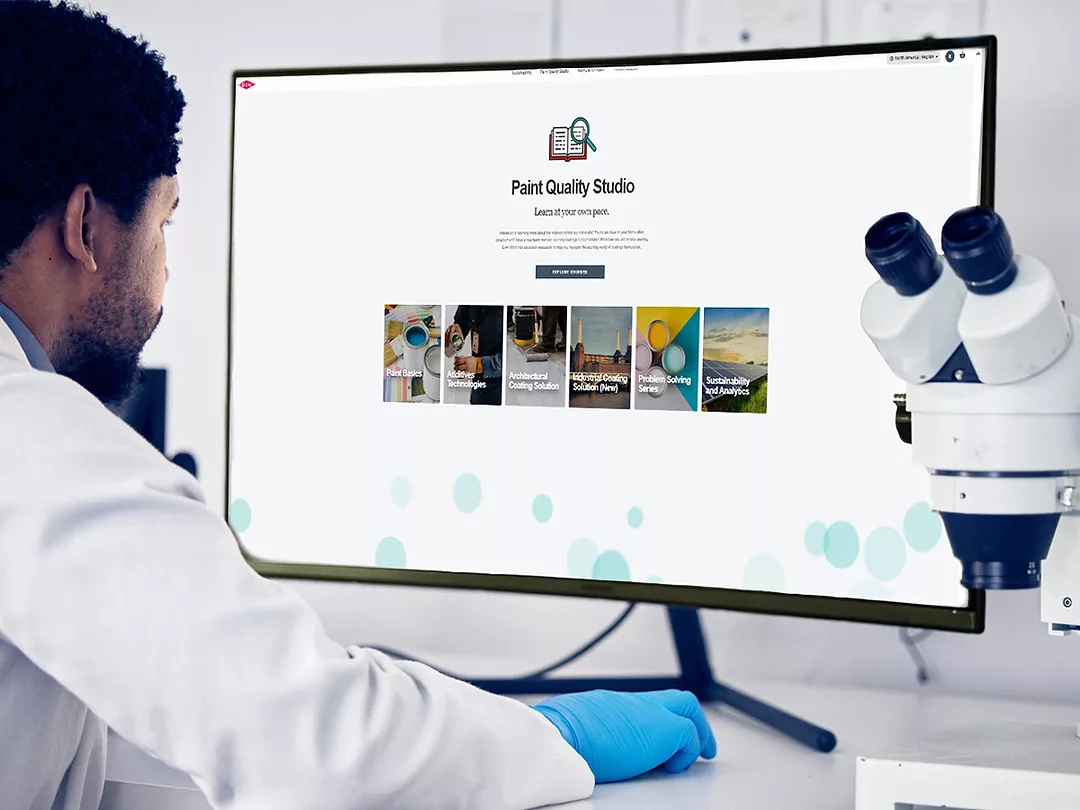The Truth About Digital Formulation
How Digital Coatings Formulation Platforms Can Help Accelerate Innovation



New and seasoned scientists can brush up on technical knowledge or dive into features such as the problem-solving series in which Dow scientists discuss how to address common difficulties in coatings, from water sensitivity to film integrity.
Paint and coatings formulators face pressures from every corner: increasing customer demands for high-performance surface protection, tighter environmental regulation, as well as a need to speed production time, drive innovation, and deliver new products – all while containing costs.
Despite these growing demands, the formulation process looks a lot like it did 30 years ago, with spreadsheets, notebooks, and time-consuming rounds of hands-on testing. The endeavor can span weeks – or even months – and involve hundreds of test samples made from dozens of resins, additives, pigments, and catalysts in seemingly infinite combinations.
But what if formulators didn’t have to meet today’s demands with yesterday’s tools? Vendors, partners, and peers throughout the coatings industry have already embraced the latest technologies to gain a competitive advantage. Imagine what could be accomplished with a digital platform backed by data, and designed to help accelerate innovation.
Harnessing the Power of Data
The intricacies of paint formulation development in the coatings industry are complex and dynamic. The task of combining over 20 different ingredients into various sheens and tint bases for end-use consumers is no small task. The challenge is further compounded by the need to develop separate product lines to cater to diverse market segments with distinct performance needs that vary by geography, quality level, and end-use application.
The use of data can greatly help in this regard. Machine learning and advanced algorithm models trained on historical formulation data can predict the properties of a new formulation based on the ingredients used. This can save significant time and resources formulators would otherwise spend on physical testing.
Another example of how the data-driven approach can provide benefits: when performance and cost targets must be balanced while adhering to changing consumer sentiments and government regulations.
Detailed data on the cost and performance of different ingredients can assist in making informed decisions during the formulation development process. Predictive models can also optimize the cost and performance of a formulation, enabling manufacturers to design cost-effective products that meet the required performance standards.
Data and data analytics can also help tackle the challenge of re-formulating product lines on a routine basis. Data on market trends and competitor strategies can provide valuable insights that can guide the re-formulation design idea.
Best Practices for a Data-Driven Strategy
Adopting a data-driven approach is not without its challenges, including data availability, subjectivity reduction, modeling strategy, and customer deployment and adoption. The complexity of the formulation space presents a significant challenge to modeling strategy as well.
Scientists seeking a data-driven strategy for coatings formulation will benefit from investing in the following technologies:
- Automation: High-throughput research and automation help to standardize data collection and increase testing capacity.
- Computer vision: These algorithms provide accurate and quantitative assessment of coating appearance, addressing the industry's reliance on subjective visual assessments.
- Advanced modeling: Developing advanced modeling techniques that combine empirical knowledge with contextualized historical data offers a practical approach to predictive modeling.
- Accessibility: The final hurdle is customer deployment and adoption, which requires translating sophisticated algorithms into an accessible and easy-to-use IT framework and user interface.
While adopting a data-driven approach in the paint formulation process presents significant challenges, the potential for further innovation offers a promising future. The use of data and modern tools can significantly enhance the formulation process, streamline testing, and improve the customer experience, revolutionizing the industry.
Data and the Digital Lab
When paints and coatings are built on this solid foundation of data, the results are more likely to perform in the real world – and at a fraction of the time required by traditional laboratory methods. According to researchers at the University of Maribor, a digitalized lab cuts almost 48% of the time required to create a new formulation, compared to the analog method.1 The time savings support formulators to fail faster, innovate more widely, and achieve a faster time to market.
Need to formulate for water sensitivity? UV resistance? Higher sustainability standards? Rather than manually gathering this information through trial and error in the physical lab, digital paint formulation tools balance needs and deliver data-driven solutions tailored to performance and cost requirements.
Formulating for Success
Industry professionals at every skill level can use digital formulation platforms to formulate new solutions in record time.
DOW™ Paint Vision is a digital platform that combines decades of insight and expertise with next-generation technology in a holistic, user-friendly hub of tools and resources. It connects decades of R&D experience with thousands of data points collected from Dow labs, and merges them with the latest trends in sustainability and end-user needs.
The platform allows for the comparison of products across a range of attributes, from stain blocking to scrub resistance. With AI-powered tools, formulators can discover the right binder, dispersant or rheology modifier for their project, compare options, then order a sample and try it out.
Within Dow’s platform, the Formulation Xpert tool empowers formulators to match ingredients and attributes to specific applications, backed by the company’s decades of technical knowledge. From architectural binders to rheology modifiers, the tool can be used to design high-performance paints that comply with Master Painters Institute standards.
Taking the guesswork out of creating safe, long-lasting, high-performance formulations that also reduce environmental impact is a key focus area for many formulators. The platform’s OpTiO2nizer™ Reformulation Tool offers an instant way to decrease the amount of titanium dioxide in any formulation – driving down both carbon emissions and costs, and promoting more sustainable formulations.
Self-Paced Study for Scientists
One of the biggest challenges that formulators face is education. Whether welcoming new hires into the lab or expanding the knowledge of more tenured scientists, Paint Quality Studio – an online, curated collection of more than 100 self-paced videos – can also help reduce the time formulators need to get up to speed. Covering everything from resins and additives to architectural and industrial coatings, it’s a powerful resource for scientists to learn directly from industry experts.
Turning Ideas into Action
Paint formulation is a complex, technical process – one that hasn’t changed much in decades. To remain competitive and drive innovation, formulators must embrace the digital future with data-driven tools that automate tasks and save time.
However, simply digitizing scientific procedures that have long been traditionally manual in nature is not as simple as it sounds. The journey to a digital lab is a multi-step process that requires a sound strategy. Formulators face significant investments in time, resources and technology to create this new reality.
There’s no need to face the digital future alone. By combining powerful data and decades of knowledge, digital coatings formulation platforms are a valuable partner in this transformation, breaking down obstacles so that formulators can spend more time innovating.
For more information, visit DOW™ Paint Vision.
References
1 Kern, T.; Krhač, E.; Senegačnik, M.; Urh, B. (2023, Oct 18). Digitalizing the Paints and Coatings Development Process. Processes. https://www.mdpi.com/2227-9717/7/8/539
*All images courtesy of The Dow Chemical Company.
Looking for a reprint of this article?
From high-res PDFs to custom plaques, order your copy today!







